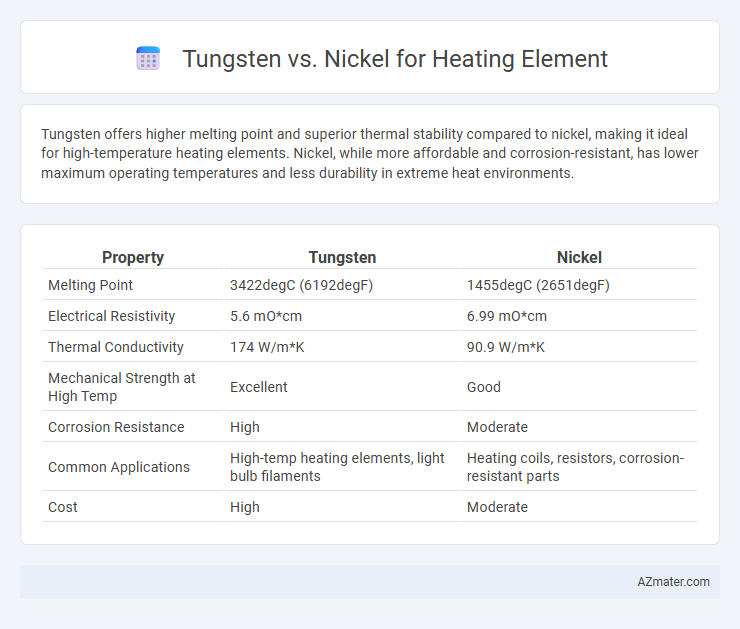Tungsten offers higher melting point and superior thermal stability compared to nickel, making it ideal for high-temperature heating elements. Nickel, while more affordable and corrosion-resistant, has lower maximum operating temperatures and less durability in extreme heat environments.
Table of Comparison
| Property | Tungsten | Nickel |
|---|---|---|
| Melting Point | 3422degC (6192degF) | 1455degC (2651degF) |
| Electrical Resistivity | 5.6 mO*cm | 6.99 mO*cm |
| Thermal Conductivity | 174 W/m*K | 90.9 W/m*K |
| Mechanical Strength at High Temp | Excellent | Good |
| Corrosion Resistance | High | Moderate |
| Common Applications | High-temp heating elements, light bulb filaments | Heating coils, resistors, corrosion-resistant parts |
| Cost | High | Moderate |
Introduction to Heating Element Materials
Tungsten and nickel are prominent materials used for heating elements due to their high melting points and excellent electrical resistivity. Tungsten boasts a melting point of 3,422degC, making it ideal for extreme temperature applications, while nickel, with a melting point of 1,455degC, offers strong oxidation resistance and durability in moderate heating environments. The choice between tungsten and nickel heating elements depends on the required operating temperature, corrosion resistance, and mechanical strength for specific industrial uses.
Properties of Tungsten in Heating Applications
Tungsten exhibits exceptional properties for heating elements, including an extremely high melting point of 3422degC, excellent thermal conductivity, and superior resistance to thermal creep and oxidation at elevated temperatures. Its mechanical strength remains stable under extreme heat, making it ideal for high-temperature industrial furnaces and vacuum tube applications. Tungsten's low vapor pressure minimizes material evaporation, ensuring longevity and consistent performance in demanding heating environments.
Properties of Nickel in Heating Elements
Nickel exhibits excellent corrosion resistance and high oxidation stability, making it a preferred material for heating elements exposed to oxidizing environments. Its melting point of 1455degC allows it to operate efficiently at relatively high temperatures, while maintaining mechanical strength and durability. Nickel's good electrical conductivity and resistance to thermal fatigue contribute to consistent heating performance and extended element lifespan.
Electrical Conductivity Comparison
Tungsten exhibits significantly higher electrical conductivity than nickel, making it more efficient for heating elements that require quick and uniform heat distribution. Tungsten's conductivity, approximately 1.79 x 10^7 S/m, supports rapid electrical current flow, enhancing heating performance in high-temperature applications. In contrast, nickel's lower conductivity, around 1.43 x 10^7 S/m, results in slower heat buildup and reduced efficiency in precision heating devices.
Melting Point and Thermal Stability
Tungsten exhibits a significantly higher melting point at 3422degC compared to nickel's 1455degC, making it far more suitable for high-temperature heating elements. Its exceptional thermal stability allows it to maintain mechanical strength and resist deformation under continuous extreme heat. Nickel, while easier to work with, tends to degrade faster at elevated temperatures due to lower thermal stability and a lower melting threshold.
Oxidation Resistance: Tungsten vs Nickel
Tungsten exhibits superior oxidation resistance at high temperatures due to its high melting point of 3422degC, making it ideal for heating elements operating in extreme environments. Nickel oxidizes more readily at elevated temperatures, developing a protective oxide layer only up to around 600degC, beyond which oxidation accelerates. Consequently, tungsten heating elements maintain structural integrity and performance longer in oxidative atmospheres compared to nickel.
Cost and Availability Considerations
Tungsten heating elements offer exceptional high-temperature performance but come at a higher cost due to the metal's scarcity and complex manufacturing process. Nickel heating elements are more affordable and widely available, making them a cost-effective choice for moderate temperature applications. The abundance of nickel reduces supply chain constraints, ensuring consistent availability compared to the more limited tungsten reserves.
Typical Applications: Where Each Material Excels
Tungsten heating elements excel in high-temperature applications such as vacuum furnaces, aerospace propulsion, and gas turbines due to their exceptional melting point of 3422degC and superior oxidation resistance in inert atmospheres. Nickel heating elements are preferred in moderate temperature settings like electric resistance heaters, industrial ovens, and chemical processing because of their excellent corrosion resistance, affordability, and good electrical conductivity up to around 1150degC. Each material's unique thermal and chemical properties determine its suitability, making tungsten ideal for extreme heat and nickel optimal for cost-effective, chemically stable operations.
Lifespan and Maintenance Requirements
Tungsten heating elements offer superior lifespan compared to nickel due to their high melting point of 3422degC and exceptional resistance to oxidation. Nickel elements, while more affordable, typically degrade faster under high-temperature conditions, especially above 1000degC, requiring more frequent replacement. Tungsten's robustness in extreme environments reduces maintenance intervals and overall downtime, making it ideal for applications demanding longevity and minimal upkeep.
Conclusion: Choosing the Right Heating Element Material
Tungsten offers exceptional high-temperature resistance and longevity, making it ideal for ultra-high-temperature applications, while nickel provides superior corrosion resistance and electrical conductivity for moderate temperatures. Selecting the right heating element depends on operating temperature requirements, environmental conditions, and desired durability, with tungsten preferred for extreme heat and nickel favored for stability in corrosive atmospheres. Optimizing performance and lifespan requires matching the element material's thermal and chemical properties to the specific application demands.

Infographic: Tungsten vs Nickel for Heating Element
 azmater.com
azmater.com